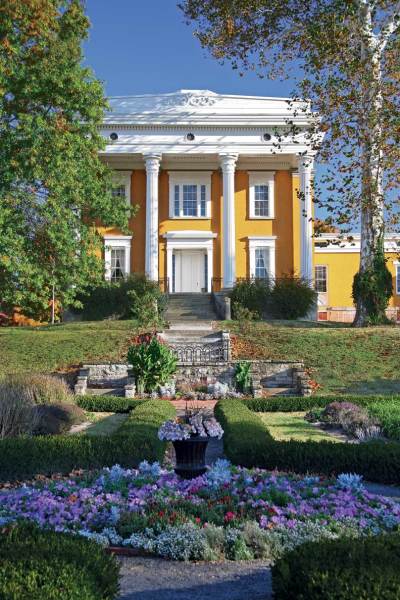
The imposing Lanier House, with its grand Greek Corinthian portico, is the masterwork of architect Francis Costigan. It sits high above formal gardens that descend to the Ohio River.
Madison, Indiana, is sitting on a secret: Its treasure trove of Greek Revival houses is celebrated among architectural historians, but many old-house aficionados have been kept in the dark—until now.
Madison is a quiet little city on the banks of the Ohio River halfway between Cincinnati and Louisville, and a couple of hours south of Indianapolis. For a few heady decades after its circa-1809 founding, Madison’s waterfront experienced a steamboat-era boom—its population swelled, and its citizens prospered. The town seemed set to become a mighty metropolis in the Old Northwest Territory.
Then, beginning in the 1840s, a rash of railroads chugged into, and beyond, Indiana. The torrent of land-hungry migrants from the East swept westward along routes that bypassed Madison. Trade and industry found other paths as well, and all too soon Madison’s prospects for big-city stardom took a downward tilt. Turns out, that’s great news for folks who love beautiful old buildings in storybook settings.
Rich History
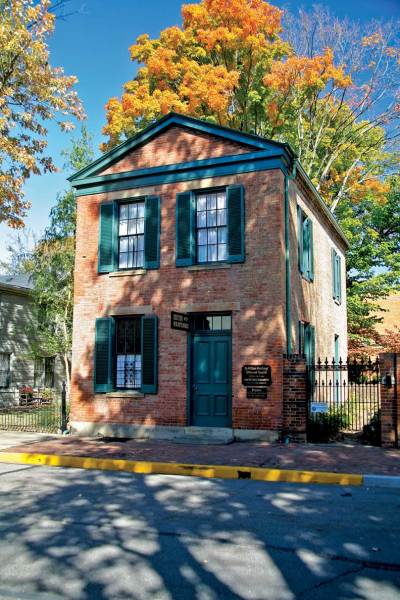
A diminutive pedimented façade marks the office of Dr. William Hutchins, built in the early 1840s. Today it is a Historic Madison Inc. museum.
Long years of benign neglect left Madison with its natural river-valley beauty intact—and also with one of the nation’s finest collections of Greek Revival buildings. Its historic district (Indiana’s largest) contains more than a thousand buildings representing virtually every decade—and every architectural style—of the 19th century. All told, it’s a lovely architectural symphony whose most delicious accents happen to be Greek.
It was Francis Costigan (1810-1865), a gifted young carpenter-builder-architect from Baltimore, who set the tone for Madison’s remarkable antebellum architecture. Costigan moved to Madison near the height of the great depression of 1837, at a time when Indiana was still the “West,” a frontier yet to be built upon. He brought with him a solid grounding in the Greek Revival style, America’s first truly national building style.
Costigan’s first great commission was the home of Madison banker James F.D. Lanier, built from 1844-46 at 511 West First Street. Lanier’s stuccoed-masonry mansion is, in the words of local historians John T. Windle and Robert M. Taylor, “classic, cubic, and massive.” Its main entrance, a colossal, four-columned (tetrastyle) Corinthian portico, faces the river, and terraced gardens roll down to the waterfront. Eyebrow windows punctuate the heavy frieze surrounding the top of the building.
On the land façade, a carriage entrance features a small, columned porch; its stylishly tall door with two vertical panels is flanked by sidelights. The low-sloped roof is topped by an octagonal lantern (or cupola). Elaborate Greek-style ornament on and around the house is made of wrought iron, instead of Madison’s more common cast iron. Lanier, who provided loans that supplied Indiana’s army during the Civil War, lived in his $50,000 mansion for only a few years before moving to New York.
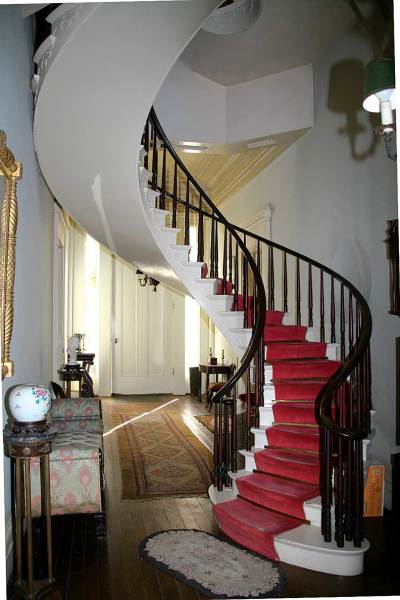
The finely decorated interior of the Shrewsbury-Windle House is famed for its freestanding spiral staircase rising from the entrance hall to the third floor.
Lanier House is now a state-owned house museum, so visitors can go inside to admire the fabulous cantilevered spiral staircase in the huge center hall that separates the double drawing rooms from the dining room. Like the outside trim, the interior decoration is bold and beautiful.
Almost as grand, if not quite as showy, is Costigan’s other major commission, the brick Shrewsbury-Windle House (1846-48) at 301 West First Street. Captain Charles Lewis Shrewsbury was a man of many interests—a prosperous merchant, mill owner, and sometime-mayor of Madison—and his home reflected both his wealth and Costigan’s taste and skill. Here, the architect once again employed an “unsupported” spiral staircase rising to the third floor (probably inspired by Minard Lafever’s instructive book of the period, The Modern Practice of Staircase and Handrail Construction, 1838). The river façade is enriched by a fine entrance porch in Costigan’s beloved Corinthian order. Perhaps in a nod to the virtues of the modern foundry, the ironwork at Shrewsbury House is of cast iron. The house was recently bequeathed to Historic Madison Inc. by its last private owners, John and Ann Windle, and will be restored as a historic house museum.
Home Again
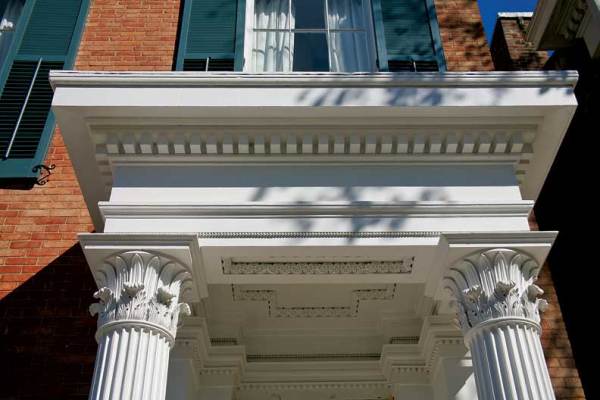
Costigan’s own house (1846-49) has a perfect small entrance portico with his signature Greek Corinthian capitals, modified with Egyptian lotus leaves in a distinctive design.
Costigan’s own home, built from 1846-49 at 408 West Third Street, is a compact but elegant tour-de-force on a dauntingly narrow lot. Its curved entry hall and bow-end parlor pack an architectural wallop that belies its small size. The quiet brick exterior sports a perfectly scaled dentilated cornice; a sophisticated little entrance porch with two proper Greek columns (i.e., with ornate capitals but no bases); tall, large-paned windows; an imposing door; and simple but bold stone window lintels and sills. Historic Madison Inc. operates the Costigan House as a fully furnished museum.
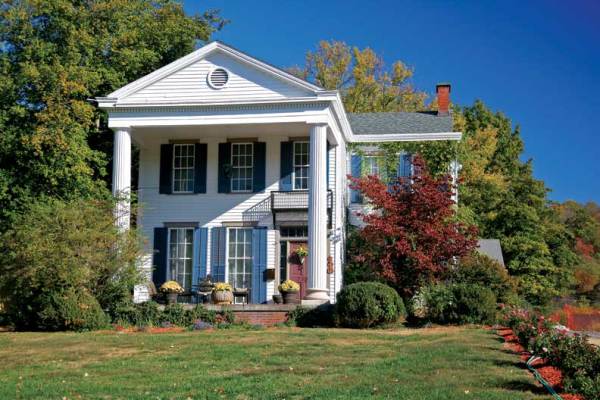
The two-columned pedimented portico on this house is unusual, and possibly an alteration to the core Greek Revival design.
More modest still, but nonetheless a good guide to the best Greek Revival characteristics, is the Costigan Double House (circa 1840) at 415-417 Vine Street. In this side-gabled brick house, side-by-side recessed entries ensure the privacy of two families. Heavy, molded cornices at the roofline and across the double entry are typical of the style. Before he built his house on Third Street, Costigan lived on
one side and rented out the other.
If you find yourself marveling at so much splendor in such a remote area—well, remember all those steamboats and railroads. Even in a newly settled frontier state, it was possible to acquire the essentials and furbelows of a home-builder’s dreams.
Online exclusive: Need more Greek Revival inspiration? Check out these house museums!







